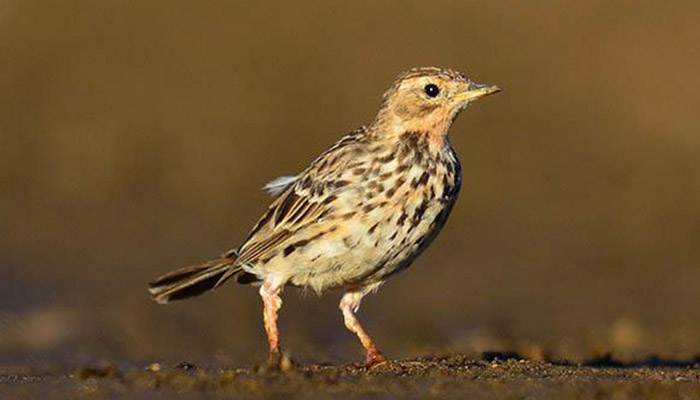
English: Red-throated
Pipit
Russian: Краснозобый конёк
Mongolian:
Зосонгүеэт шийхнүүхэй
German: Petschorapieper
French: Pipit de la Petchora
Japanese: セジロタヒバリ (Sejiro-tahibari)
Body length: 14-15 cm.
Breeds sparsely on bare mountains and tundra in northern most Europe, on
swampland in willow zone and open, low upland birch forest with grassy patches.
Summer visitor winters in Africa and locally in Middle East. Vagrant Britain
& Ireland (mostly Apr-Jun, Aug-Nov).
Identification: Resembles Meadow Pipit in size and shape, and
occurs on passage (at ties also breeds) in same habitats as that species.
Normally, however, only autumn immatures present identification challenge. In
all plumages heavily black-streaked above, including back and rump (Meadow
Pipit only poorly marked on rump), with brown ground colour and some rufous and
whitish fringes (lacks olive tinge shown by most autumn Meadow Pipits).
- Adult:
Easily told by rusty-red throat. Some (prob. mostly ♂♂) also have rusty-red on
supercilium, forehead and upper breast, as well as having these areas
completely unpatterned (thus lack dark lateral throat stripe); others (prob.
mostly ♀♀) have more restricted rusty-red and are heavily streaked. The rusty
colour is retained in autumn (winter plumage), but is initially more
yellow-brown in tone.
- 1st autumn:Lacks
rusty-red on throat, which is buff-white. Note heavily dark-streaked upperparts
with brown rather than olive-grey ground colour, distinct pale tertial edges,
pale lores, complete narrow whitish eye-ring, thin bill with bill with usually
yellowish base to lower mandible, whitish stripes along mantle, and often
strong black wedge-shaped streak on lower throat-side.